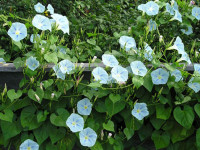It’s a shame, but vines are underused in our gardens nowadays. Perhaps it’s because most home gardens have fewer fences, porches and arbors than were common a century ago. Or because vines have a mostly undeserved reputation for pulling down houses, smothering trees, and generally running amok.
Kudzu aside, we’d like to see them used more often. There’s nothing quite like a well-grown Clematis to really knock your socks off when in full bloom, except maybe a Wisteria dripping with honey-scented blossom, or a Morning Glory with hundreds of flowers all bluer than the sky and wet with dew.
Vines make great screens, especially in the summer when we most want to sit outdoors, unobserved. The classic vine for screening a porch is the Dutchman’s Pipe, Aristolochia durior, with huge leaves overlapping like heart-shaped shingles. Honeysuckles are of two sorts: the deliciously fragrant varieties from Europe and Asia, and their bold red and gold American cousins, scentless but irresistible to hummingbirds.
Many vines can do double duty as groundcovers. Try the gorgeous Climbing Hydrangeas (Hydrangea petiolaris and Schizophragma hydrangeoides) scrambling over rocks or low walls, or even our common Virginia Creeper, Parthenocissus quinquefolia. Another great vine in the same genus is Parthenocissus tricuspidata, the Boston Ivy. Few plants color up more beautifully in the fall.
For late summer flower power, nothing beats some of the annual vines, well worth the trouble of seeking out or growing from seed. The aforementioned Morning Glory is a classic almost everyone recognizes, but how about trying the Purple Hyacinth Bean (Dolichos lablab) or the flame-colored Spanish Flag (Mina lobata)? Although they must be replanted every year, they can quickly reach ten feet or more, and cover themselves with flowers until frost.
So look around your property and find a fence or wall that looks bare, an arbor that needs a flourish, or an unsightly shed that needs draping, and give these adaptable, useful and beautiful plants a try. You’re sure to be richly rewarded for years to come.




